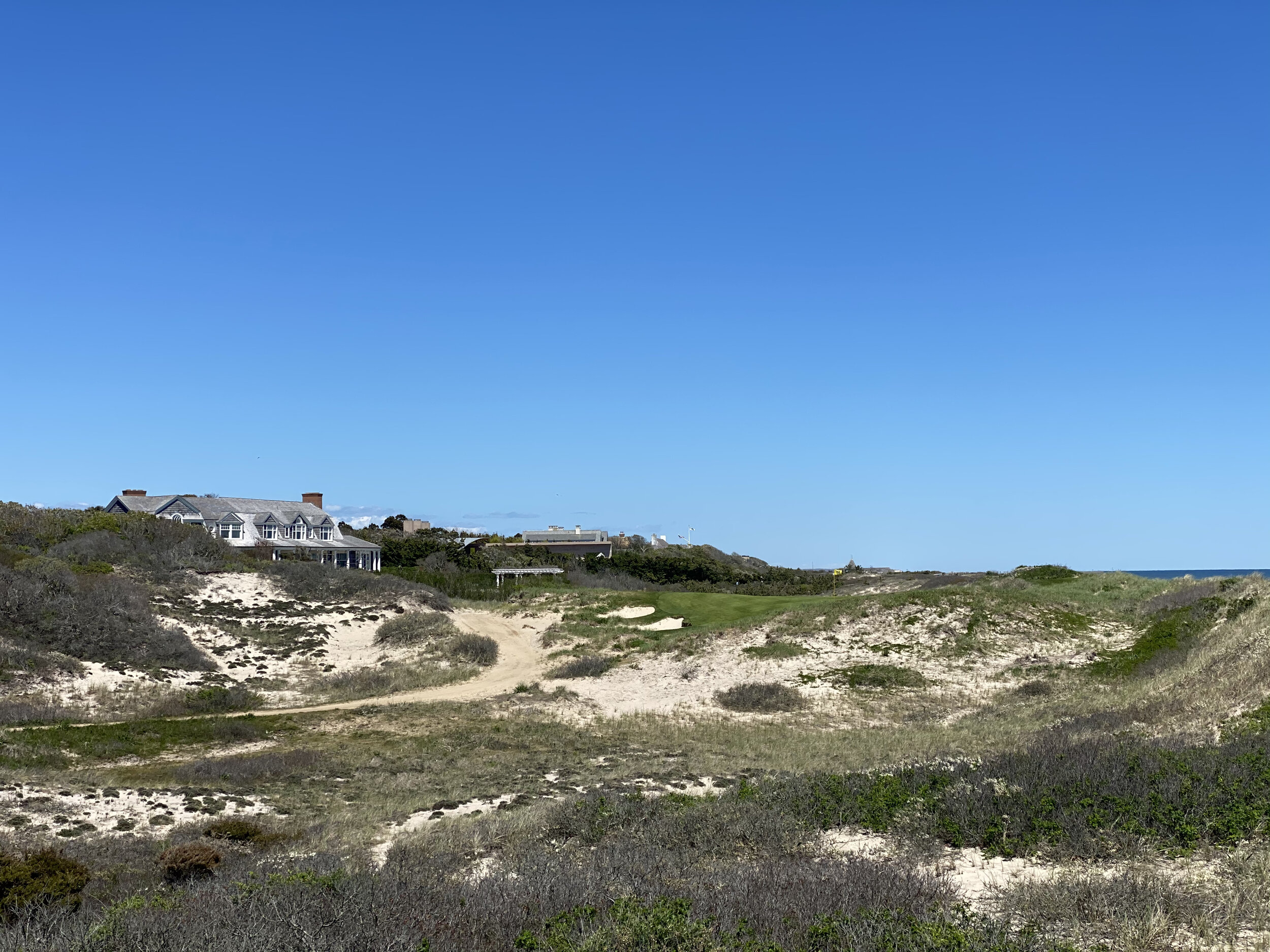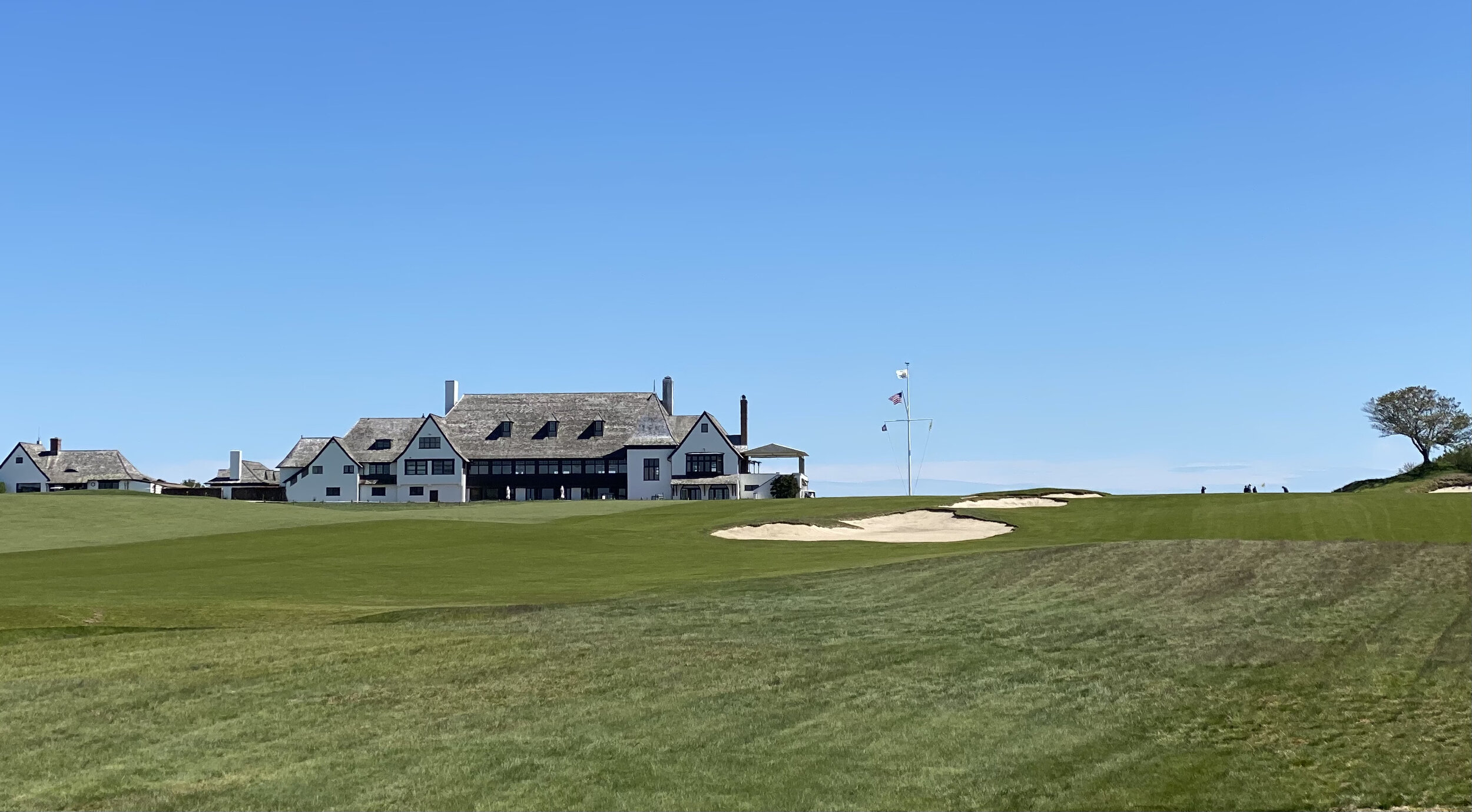I played in a charity golf event at Maidstone in May 2021. I had never played at the Club before, and I enjoyed the day, partly because I scored well (75) and won low gross (72). I’m not sure how this turned out that way, but the format adopted was the Callaway scoring system, something new to me.
Maidstone Clubhouse
The Club is a good drive from Manhattan, and as you get closer you can run into some pretty bad traffic after the Shinnecock Canal. It’s always amazing to me how different this part of New York is: fabulous homes, a certain serenity about life, lovely beaches and gorgeous sunsets. Quite different from the reality most New Yorkers endure just a couple of hours away.
The Club was formed in 1891. Don’t go looking for much information from the Club’s website: https://www.maidstoneclub.org
Here’s some information from wiki: The Club derives its name from the original name for East Hampton, which was Maidstone, named after Maidstone in England. It was founded as a 7-hole course in 1894 and expanded to eighteen holes in 1899. The Club was the summer retreat of New York City’s most wealthy and socially connected families. Maidstone is considered to be the most elite, prestigious and difficult to get into of all the clubs in “The Hamptons”.
Several notable people have inquired about membership over the years and were summarily prevented from joining the Club. In the 1950s, Groucho Marx was able to play as a member guest but was turned down as a potential member. George Plimpton and Diana Ross were also shunned. Ross was married to billionaire Norwegian shipping magnate Arne Næss, Jr., a member at Maidstone, however he resigned when his wife was denied membership. Donald Trump was a temporary member in the early 1980s, but turned down as a permanent member.
Willie Dunn laid out the first course in 1894; it was but a rudimentary 7-hole layout. Seth Raynor drew up re-design plans in 1921. Then in 1924 Willie Park, Jr. and his brother Jack designed the 80-acre (320,000 m2) Gardiner Peninsula addition. The expansion resulted in the club having two 18-hole courses, but this was reduced to the current 27-hole layout by the hurricane of 1938.
The Parks' routing on the 80 acres on Gardiner’s Peninsula and the remaining 50 acres introduces multiple hazards at various angles, including a marsh, Hook Pond, sand dunes, beach grass, reeds, well-placed bunkers, out of bounds and the ever-present wind.
The Club ranks highly: Golf Digest has it at 64 in the world. There are some great holes, and the wind represents a major challenge on occasion. Here’s a pic of my dear friends Arthur, Fasto and David and me during our round on the 18th tee looking back at the Clubhouse:
As you can see it was a gorgeous day.
Finally here’s me with my winning smile and prize:
As mentioned, the event was scored according to the Callaway scoring system. I did a quick check on the putting green before the event and no-one I asked knew what this was. I checked on google and here’s what I found - and I love the final “warning”:
The Callaway System is a handicap algorithm designed to provide a handicap estimate based on one round of play. The Callaway 'handicap' can then be used to calculate a net score for that round. The Callaway system is quite popular for company outings and tournaments where most golfers do not have handicaps. It is also relatively straightforward to calculate. We explain the Callaway calculation below.
The Callaway system is a "worst-holes" calculation, in that it uses up to six of the player's worst holes in a round, adjusted by a 'factor,' to obtain a handicap. That handicap is then subtracted from the player's gross score to obtain a net score. The net scores for all players can be compared to see who will win the tournament prize.
Use the table below to calculate your Callaway handicap. First, look up your gross score on the left side of the table, and find how many holes you will need to use to calculate your handicap.
Next, take look up the # of worst scores (for 2 1/2, the third worst score is divided by two), but with the following rules:
Worst scores cannot be used from the 17th and 18th holes (it is too easy to throw the last few holes if a golfer is ahead)
For any worst score that is greater than twice the hole par value, only twice the par value should be deducted (in the spirit of ESC)
Once the scores are added up, round up any fractions to the next higher number (e.g. a 7 on a par five that counts as half a worst score should be rounded up to a 4)
Finally, adjust the sum of those scores by the adjustment factor. To find the adjustment factor, look up your score in the above table. At the bottom of the table, in the same column, is the adjustment factor. If your sum of worst holes is 18, and your gross score is 89, than your adjustment factor is +1 and your Callaway handicap is 19.
Your net score is simply your gross score minus your Callaway handicap (in the above example, your net score is 89 - 19 = 70).
Here is an example: Imagine a Callaway tournament where you shoot a 95. You look up in the table and find that your Callaway handicap is your 2 1/2 worst scores plus an adjustment factor of +2. Your four worst scores are an 8 on a par 5, a 7 on a par 5, a 7 on a par 4, and a 7 on a par 3. But, your worst score, the 8, took place on the 17th hole and therefore cannot count towards your Callaway handicap. In addition, because your 7 on the par 3 is more than twice the par value, it can only count as a six towards the Callaway handicap. The resulting handicap is 7 + 7 + 6/2 + 2 (Adj Factor) = 19. Your net score is 95 - 19 = 76.
A Quick Warning
Many people feel that though the Callaway system gives a sense of competitiveness, it is unreliable and biased towards better players - i.e. even though players with higher gross scores will be given net scores within a few strokes of the leaders, the player with the lowest gross score will be more than likely become the low net score winner. Nonetheless, many people enjoy using the Callaway system for tournaments, as it always adds excitement and is better than competing solely on a gross score basis.
Well, that’s it. So I guess my 75 turned into 72 as you can see below.
So, a great day out. The staff at the Club were so nice. They have a great head pro, Eden Foster.







